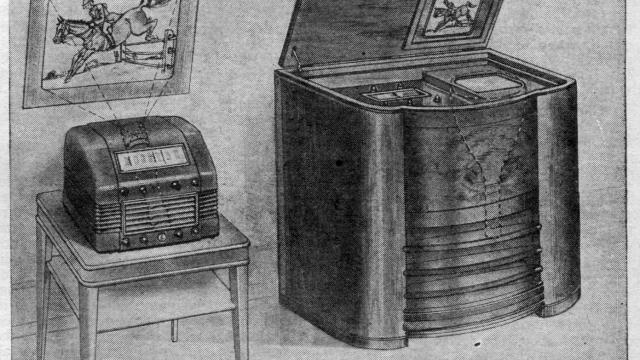With the nation focused on World War II, Americans of the early 1940s understood that they’d have to wait until peacetime for all their shiny new futuristic gadgets to arrive — including the TVs of the future, shown above in illustrations from the Emerson Radio and Phonograph Corporation. If you can believe it, these were the big screen models.
Television as a technology of the future had a lot of false starts. Though TV development began in earnest in the 1920s, the Great Depression ensured that fewer resources were poured into research during the 1930s. Slowly but surely, though, the major radio companies continued work and by 1939, TV had its coming out party at the New York World’s Fair — only to again be derailed, this time by World War II.
During the war, Americans saw fewer TVs of the future depicted in magazines and newspapers than they had in the previous decades. But the ones they did see focused on two very important attributes: screen size and price. Much like American homebuilders, who promised that if people would just be patient , great things were coming after the war, TV and radio manufacturers told consumers, “just you wait.”
“It is our plan to feature these sets for no more than $US150 as compared with the pre-war average price of $US500 to $US800 for the 12-inch image type of receiver,” the president of Emerson said at the time.
A high-tech TV for just $US150 may sound like a bargain, but adjusted for inflation, that was nearly $US2,000. Not exactly a great deal, especially given the lack of programming in 1944. Television was still very much an early adopter’s toy during World War II.
But not only were prices supposed to come down, the screens were supposed to get bigger, and much more advanced. Projection TVs, which manufacturers compared to home movie tech of the time, were going to find a place in America’s living room.
From the February 1944 issue of Radio-Craft magazine:
The television instrument, planned by Emerson engineers, approximately 18 inches wide and 14 inches high, will be a complete radio and television unit employing a three-inch cathode ray tube. The television image will be enlarged and projected to 15-by-20 inch proportions with a motion picture screen, by means of a lens system made of plastics. The brilliance will equal that of home movies.
Unfortunately for people who dreamed that cheap big screen TVs would arrive after the war, it wasn’t exactly instantaneous. By 1946 there were only about 20,000 TV sets in the entire country (roughly .02 per cent of American households) and only six local TV stations in the United States: three in New York City, one in Schenectady, one in Chicago, and another in Philadelphia.
But that would change dramatically over the next decade. TV ownership in the US would jump to 30.5 million sets by 1955; by that time, 64 per cent of American households had a TV. And they were indeed demanding larger sets. As the book The Columbia History of American Television points out, surveys from the postwar period showed that people who were buying TVs weren’t messing around with tiny screens. 77 per cent of people who were likely to buy a set insisted on nothing less grand than a full 16 inches.
Image: Scanned from the February 1944 issue of Radio-Craft magazine
Statistics on TV ownership: The Columbia History of American Television
